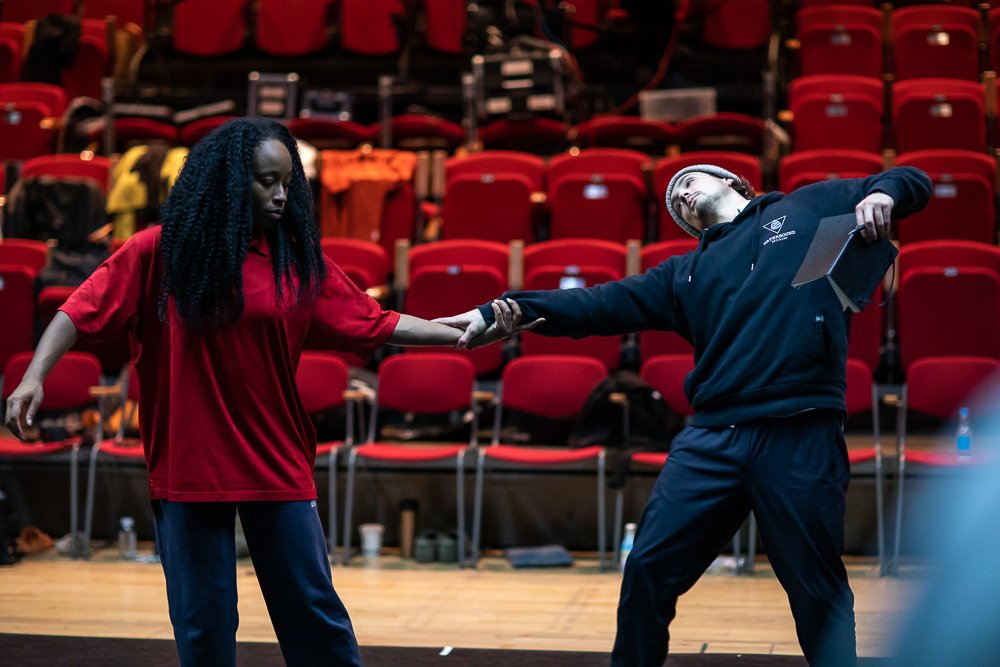
“As much as anyone else, I can self-edit, become apologetic and condemn my less-brilliant movement attempts. Edd and Alethia made me realise that such a response is not necessary or helpful, rather it seems a bit frivolous, certainly a waste of time and energy and only serves to draw attention to the mistake or failure. They showed, rather than [verbalised] this approach. It was non-verbal, authentic and compelling.”
EncoreEast / RMDC choreographic project – Dance Artist Reflections, by Edd Arnold
Photos (c) Roswitha Cheshire
Taking Russell Maliphant's piece Silent Lines as inspiration, RMDC dancers Alethia Antonia and Edd Arnold were able to take forward their keen interest in creating work with older dancers as part of their professional development during this collaborative choreographic project with EncoreEast. RMDC is striving to examine/unpick Russell's practice and explore how this may be disseminated and carried forward with depth and quality by our delivery team of company dancers in education and community settings. Here Edd reflects on the uniquely fascinating learning process that has come from working on Focus amidst the pandemic.
How did you feel about entering into this project with the first classes happening on Zoom?
I felt good. The aim for me was just to get to know the dancers and explore possibilities. It was research as well as training for them in the style that we were going to work in, drawing from Russell’s teachings, so that when we did meet in person we would have a common language. But more than that, it was just a time to get to know them and for them to get to know us.
We structured the zoom classes to be an hour and a half including a break and a creative task which we used to try different things each week to see what the dancers lent towards doing and what they avoided doing. We drew from that, reflecting on it and trying to bring in the next week some of what they didn't do much of and amplify what they were already doing really beautifully, so in some way we created an essence of what could be done when we did get into the space. It was really nice actually, the Zoom training. We may have missed out on details but it gave an opportunity for everyone to really try, without anyone watching, which was really beneficial. In their room they had no one watching, they were just taking instructions and trying things out in a really honest and vulnerable way because there wasn't a big studio where everyone could compare themselves to each other. So we just had everyone on their own journey, which was really nice to see.
On the other hand, as classes are really designed for dance studios (where you do have space and you have a certain type of floor), working on Zoom where some people were really blessed with their space and others may only have had a corner of a room with a thick carpet, made it harder. When you wanted to invite some people to expand into the room they had and also keep the people who had smaller spaces just as involved it became hard to juggle, whereas when you're in a dance studio, everyone is equal in that sense, with the same opportunity to take the space as everyone else.
From that starting point, how did you then set about planning the work that you would do with the company once you were live and back in the studio?
Alethia and I were fairly restricted in the time we had with the dancers once back in the studio, with slightly shorter days than you would work as a professional dancer, in two-day blocks with sometimes over a week’s gap in between, so we had to think carefully about how we would approach this work. It would be nice to get into a space and have two consecutive weeks to develop something and let it unfold in front of us through a kind of creative play, which isn’t as easy with longer gaps between when you have to spend time ‘re-finding’. So Alethia and I decided we needed to plan very much ahead and know roughly the structure of what we were going to create in advance, including lighting elements. We wrote down a plan of five sections using Silent Lines as a reference. It was good to have that reference point, but we also wanted it to be a piece that was a result of the collaboration between us and the EncoreEast dancers. We were trying to find that balance, which I think we found, but it was a different approach to what we might have liked initially. We still managed to find time for a lot of exploration, but we needed to make very quick decisions about whether it was working.
Is there anything that you've learned throughout the process of working with this group of dancers in this way that you will take with you into future projects?
I've tried through the whole process not to make too many decisions based on the fact that this is a company of older dancers and one thing I've learned is how we can just keep going! We can push in the same way. The things that change aren't what it's possible to create, it's just the level might change or the speed of it might change.
What's been interesting for me is using class as a tool. Away from the lights or the stage which might create a bit of resistance, “I can't do that”, using class to eventually end up in that state of movement where they're moving really fast, and they're not thinking, moving around each other in the space, and then to gently remind them, “you can do it, that's what we're doing on stage, you have it, it's possible”, to use moves and tasks to really, really inform what's possible on stage for a group of people that don't dance full time.
That's been something I've learned, helping the dancers to realise that they can do a lot more than they previously thought in a different context. When they're not thinking about doing something, they just do it. It’s about helping someone to bridge that gap.


